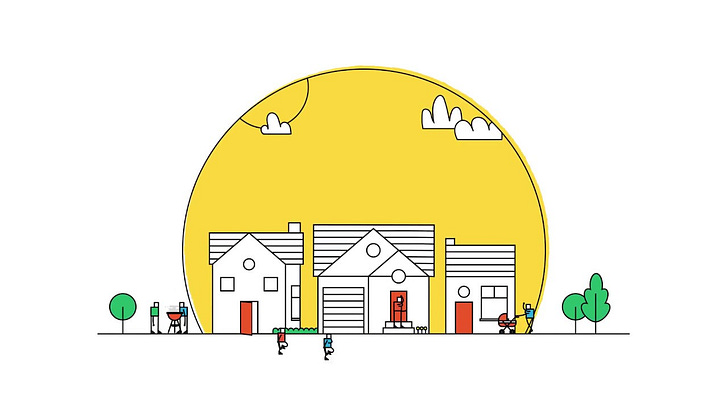Housing affordability has become a critical issue in cities across America, prompting policymakers to consider various interventions. While rental assistance programs and housing vouchers are VERY important tools for helping low-income families, they cannot solve the affordability crisis on their own. Think of these subsidies as a very limited stop-gap measure that is only necessary because of a local/regional/national market failure.
To understand why, we need to examine the fundamental economics of housing markets and the limitations of subsidy-based approaches.
The Basic Economics of Housing Shortages
When a market has fewer homes than households who want to live there, prices rise through a straightforward process of competition. Imagine a game of musical chairs where there are 100 people but only 95 chairs. Those with the most resources will always get a seat, while others are left standing. In housing markets, this competition plays out through ever-escalating rents and home prices.
This shortage-driven price increase affects the entire market, not just the lowest-priced units. As middle-income households get priced out of their preferred housing options, they begin competing for more modest units, creating a chain reaction that pushes lower-income households into even more difficult situations.
The Role and Limitations of Housing Subsidies
Housing subsidies, such as Housing Choice Vouchers, rental assistance programs, and down-payment assistance for first-time homeowners provide crucial support for low-income families. These programs help bridge the gap between what families can afford and what housing costs in their market. However, they face several important limitations:
1. Zero-Sum Competition
When subsidies increase a household's purchasing power without increasing the total number of available homes, they simply allow that household to outbid others for the same scarce units. While this helps the subsidy recipient, it can make the situation worse for unassisted households competing for the same limited housing stock.
2. Price Inflation Effects
Paradoxically, increasing subsidies without addressing supply constraints can drive market prices even higher. When more households receive assistance that allows them to pay higher rents, landlords can charge more for the same units, knowing that the subsidies will cover the increase. This dynamic can create a costly cycle where subsidies must continually increase to keep pace with rising market prices.
3. Limited Reach
Due to budget constraints, housing subsidy programs typically serve only a small fraction of eligible households. In most cities, waiting lists for housing vouchers are years long, and many eligible families never receive assistance. On average, less than 1/4 of eligible households receive a housing resource and given the current trajectory at the federal level, this is unlikely to increase any time soon.
The Essential Role of Housing Supply
To achieve lasting affordability, cities must address the root cause of high housing costs: a shortage of homes relative to demand. This requires:
1. Zoning Reform
Allow more housing types in more neighborhoods
Reduce minimum lot sizes and parking requirements
Streamline approval processes for new housing
2. Infrastructure Investment
Improve sidewalks and protected bike lanes to allow more people more choices to get around their neighborhood
Improve transit and transportation options
Create public amenities to support density (small parks, neighborhood shopping districts, and support for local schools)
3. Construction Capacity
Support workforce development and small business startups in construction trades
Reduce regulatory barriers to innovative building methods like modular and off-site construction
Provide incentives for the creation of new middle-income and affordable housing supply.
A Balanced Approach
The most effective housing policy combines both supply-side and subsidy-based solutions:
1. Expand Housing Supply: Create conditions that allow enough new housing construction to meet demand across all price points. The greatest amount of demand is coming from middle-income households. This is also the price point that is most positively impacted by zoning reform and needs relatively little incentive to work. More middle-income housing also has a near immediate impact on the availability of low and moderate income housing. Without adequate supply, subsidies are going to do very little to solve the affordability crisis at-scale.
2. Target Preservation: Protect existing affordable housing for low and moderate income households through strategic incentives while new supply comes online. Existing housing tends to be less expensive than new construction. Leverage what already exists to support low and moderate income households wherever possible.
3. Maintain Subsidies: Continue and expand rental assistance programs to help low-income households access housing in the near term, but move quickly to ensure supply can catch up. This will reduce the need for subsidies over time.
4. Support Innovation: Encourage new construction methods and housing types that can deliver more affordable options. This should include support for homeowners who want to add a backyard cottage or include a second (or third) unit within their existing home. Not only does this add to the local and regional housing supply, it also creates a passive source of income for the homeowner, helping to generate local wealth and make homeownership more affordable.
Conclusion
While housing subsidies play a vital role in helping vulnerable households access housing, they cannot solve the affordability crisis alone. Only by dramatically increasing housing supply can we create conditions for lasting affordability. Policymakers must pursue a comprehensive approach that combines thoughtful subsidy programs with aggressive action to enable more housing construction.
The path to housing affordability requires both helping people afford current market prices and bringing those market prices down through increased supply. Either strategy alone will fall short, but together they can create housing markets that work for everyone.




I agree wholeheartedly, Lee. We have more than enough room in existing neighborhoods and on existing infrastructure to “grow in” instead of growing out.
Hi Ryan...I recently completed a housing report and recommended 1.1 homes for every household...so 10% more homes. Do you have a recommendation of the housing supply needed to ensure a healthy housing market?